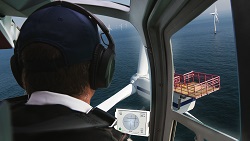Increased safety for offshore helicopter operations
An EU-funded research team has found a way of helping helicopters to approach and land on offshore oil rigs, windfarms and other remote locations safely even in conditions of poor visibility. The ANGELS project, run by Italian start up PALU and aerospace electronics designers BLU Electronic, has designed and tested a new guidance system, based on Automatic Dependence Surveillance-Broadcast or ADS-B technology, which is both affordable and easy-to-use. Helicopters provide a vital service to offshore windfarms and oil and gas rigs by delivering urgent supplies, transporting crews who have finished their stint and evacuating people in the event of a medical emergency. But when the weather or visibility is bad, they often cannot fly. “A helicopter can’t take off and land if the visibility conditions around a helipad offshore are bad,” says Beatrice Branca, communication manager at PALU. “So the big question we are trying to address is the lack of landing systems able to comply with safety regulations for helicopter operations.” More than 45 % of helicopter accidents are due to bad weather or visibility and 33 % of accidents occur during the approach or landing according to the European Aviation Safety Agency’s EHEST Safety Analysis Report 2010. Increasing situational awareness The ANGELS system harnesses the potential of ADS-B technology to make flying helicopters significantly safer by boosting the pilot’s situational awareness. “Using our app, the pilot can visualise information about the helicopter position, including its alignment with the proper approach path and the distance to the helideck as well as wind force and direction on the helideck,” says Ms Branca. The system transmits data in real time and uses a special algorithm to suggest the best flight path and give the precise lateral and vertical guidance that a helicopter needs to safely approach and land on a helipad, especially under low visibility conditions or when obstacles such as clusters of wind turbines make the flight path complicated. It consists of a ground station, comprised of a compact cabinet weighing around 20 kilogrammes that contains the ADS-B transceiver, processor and power supply, which is installed on the helideck, and an app running on an iPad used by the pilot from the cockpit. First test flight Once the prototype had been developed, the ANGELS team began testing the system in early 2016, starting with simulations and drone flights before scaling up to the first official test flight in September 2017. The system was used to guide an EC-135 P2+ helicopter to land on a helideck at an offshore windfarm off Borkum Island in North West Germany. “It performed exactly as expected and the pilot managed to follow the flight path and land on the platform,” outlines Ms Branca. The main customers for the ANGELS product could be the operators of oil and gas rigs and windfarms, according to Ms Branca, however the team has also seen plenty of interest from providers of helicopter emergency medical services (HEMS). They are now looking for funding to adapt and build on the system for specific HEMS use.
Keywords
ANGELS, helicopter safety, approach and landing, ADS-B technology, offshore helicopter operations



